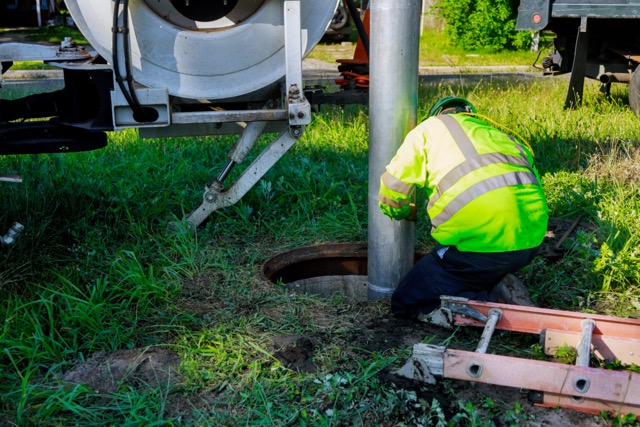In the quiet corners of our homes, beneath the surface, lies a potential danger that often goes unnoticed: septic leaks. While these leaks may seem like a mere inconvenience, they pose a significant biohazard to both our health and the environment. In this comprehensive guide, we’ll delve into the insidious effects of septic leaks, exploring the warning signs, consequences, and preventative measures to protect your loved ones, your property, and your community.
Table of Contents
What is a Septic System?
A septic system is an underground wastewater treatment structure commonly used in rural areas where centralized sewer systems are not available. It consists of a septic tank and a drain field, where wastewater is treated and disposed of off-site.

Understanding Septic Leaks
Septic leaks occur when cracks or damage to the septic tank or drain field allow untreated wastewater to escape into the surrounding soil and water sources. These leaks pose a serious biohazard, contaminating the environment and posing health risks to humans and animals alike.
Signs of a Septic Leak
Signs of a septic leak may include foul odors around the septic tank or drain field, lush patches of grass or vegetation, sewage backups in the home, or unusually high levels of nitrates in well water. Prompt detection and remediation are essential to prevent further contamination.
Consequences of Septic leaks
Septic tank leaks pose a biohazard that goes beyond unpleasant odors and unsightly grass patches. Septic water contains harmful bacteria, viruses, and parasites that can cause a range of illnesses, from gastrointestinal infections to more severe diseases.
Health Risks
Exposure to contaminated water from septic leaks can lead to a variety of health problems, including stomach cramps, diarrhea, skin infections, and respiratory issues. Vulnerable populations, such as children, the elderly, and individuals with compromised immune systems, are particularly at risk.
Biohazard Impact
One of the many impacts of septic leaks is far-reaching, affecting local water sources, wildlife habitats, and ecosystems. Nutrient-rich wastewater can lead to algal blooms, oxygen depletion, and contamination of groundwater, posing risks to both human and environmental health.
Remediation and Cleanup
Remediation of septic leaks involves repairing or replacing damaged components of the septic system, as well as cleaning up and decontaminating affected areas. Proper disposal of contaminated soil and water is essential to prevent the further spread of biohazard materials.
Preventative Measures
Preventative measures such as regular maintenance, inspections, and proper usage of the septic system can help prevent leaks and minimize the risk of biohazard contamination. Avoid flushing non-biodegradable items, chemicals, and excessive amounts of grease down the drain.
Importance of Regular Maintenance
Regular maintenance of your septic system is crucial to identifying and addressing potential issues before they escalate into full-blown leaks. Pumping the septic tank every 3 to 5 years and scheduling annual inspections can help prolong the life of your system and prevent biohazardous leaks.

Professional Inspection
A professional inspection of your septic system by a qualified technician can provide valuable insight into its condition and identify any potential leaks or damage. Consider scheduling an inspection every 1 to 3 years, depending on the age and usage of your system.
Cost Considerations
The cost of repairing septic leaks can vary depending on the extent of the damage and the necessary repairs. While remediation and cleanup may be expensive, the long-term health and environmental benefits outweigh the financial costs.
Insurance Coverage
It’s essential to review your insurance coverage to determine if septic leaks are included in your policy. While some homeowners insurance policies may cover certain types of water damage, coverage for septic leaks may require additional endorsements or specialized policies.
Myth vs. Reality
Myths surrounding septic systems and leaks abound, from the belief that septic tanks never need to be pumped to the misconception that additives can eliminate the need for maintenance. Separating fact from fiction is essential to ensuring the proper care and maintenance of your septic system.
Conclusion
Septic leaks pose a significant bio-hazard to both human health and the environment. By understanding the signs, consequences, and preventative measures associated with septic leaks, we can take proactive steps to protect ourselves, our communities, and our planet from the dangers of untreated wastewater contamination.
FAQs
1. What causes septic leaks?
Age, poor maintenance, tree root intrusion, and soil movement are just a few causes of septic leaks.
2. How do you identify septic system leaks?
Look out for signs such as foul odors, lush patches of grass, sewage backups, and unusually high levels of nitrates in well water.
3. Are septic leaks dangerous?
Yes, septic leaks pose a significant biohazard, containing harmful bacteria, viruses, and parasites that can cause illness in humans and animals.
4. How can you prevent septic leaks?
Regular maintenance, inspections, and proper usage of the septic system can help prevent leaks and minimize the risk of contamination.
5. How often should you pump my septic tank?
It’s generally recommended to pump the septic tank every 3 to 5 years to remove accumulated solids and prevent clogs and backups.
6. Does homeowner’s insurance cover septic leaks?
Coverage varies depending on the policy and the cause of the leak. Review your insurance policy or consult your insurance provider for details.
7. Can septic leaks affect your well water?
Yes, septic leaks can contaminate groundwater, leading to elevated levels of bacteria, nitrates, and other contaminants in well water.
8. What should you do if you suspect a septic leak?
If you suspect a septic leak, it’s essential to contact a qualified technician immediately to assess the situation and recommend appropriate remediation measures.
9. Are there any DIY remedies for septic leaks?
DIY remedies for septic leaks are not recommended, as they can exacerbate the problem and pose health and environmental risks. It’s best to leave remediation to trained professionals.
10. How much does it cost to repair a septic leak?
The cost of repairing a septic leak can vary depending on the extent of the damage and the necessary repairs. It’s advisable to obtain multiple quotes from reputable contractors for an accurate estimate.
PuroClean Property Savers provides emergency restoration services 24 hours a day, seven days a week. Our services include water damage, fire & smoke damage, mold remediation, biohazard cleanup, reconstruction and large-scale commercial property damage. We service Austin, Bastrop, Buda, Cedar Creek, Cedar Park, Del Valle, Dripping Springs, Elgin, Georgetown, Hutto, Kyle, Leander, Manor, Marble Falls, Pflugerville, Round Rock, Taylor, and Wimberley. Our average “on-site” time is 60 minutes, and we work directly with your local insurance provider.
Our role goes beyond just repairing properties; it’s also repairing lives. Visit us online at “PuroClean Property Savers.” Give us a call now at (512) 956-5700 or email us at [email protected] to schedule a visit.
You can also find additional resources for emergency management, fire prevention planning, flash flood situations, and many other risks at the City of Austin Fire Department initiative #LetsGetRealATX.




 PuroClean Property Savers
PuroClean Property Savers